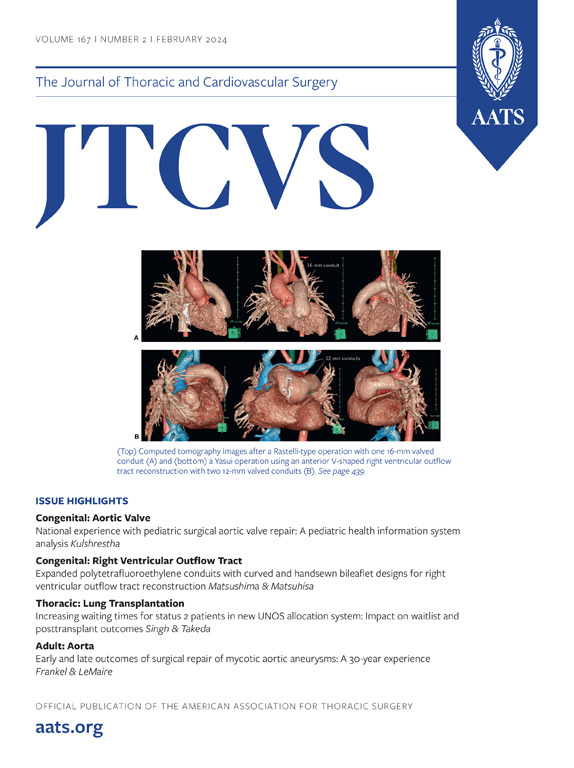房室隔缺损修复术后左房室瓣手术的疗效。
IF 4.9
1区 医学
Q1 CARDIAC & CARDIOVASCULAR SYSTEMS
Journal of Thoracic and Cardiovascular Surgery
Pub Date : 2024-10-09
DOI:10.1016/j.jtcvs.2024.09.051
引用次数: 0
摘要
目的:修复房室间隔缺损(AVDS)后的左房室瓣(LAVV)手术可能具有挑战性。我们试图描述需要进行 LAVV 手术的患者的特征和预后:方法:回顾性分析 2000-2020 年间需要进行 LAVV 手术的 AVSD 患者。将发生不良事件(AE,定义为需要再次进行 LAVV 手术(修复或置换)或死亡)的患者与未发生不良事件的患者进行比较。不良事件发生率采用 Kaplan-Meier 法显示。再手术和死亡的特征是累积发生率函数,使用竞争风险模型进行估算:在 843 名接受过 AVSD 修复的患者中,59 人(7.3%)需要进行 LAVV 手术,7 人(9%)需要进行瓣膜置换术。26例(48.1%)进行了简单修复(裂隙闭合和/或瓣环成形术),28例(51.8%)使用多种技术进行了复杂修复。11名患者(20%)需要再次进行LAVV手术;其中3人更换了机械瓣膜,6人更换了新瓣膜(2人更换了美乐家瓣膜,4人更换了机械瓣膜),2人进行了重新修复。1年、5年、10年和15年的无AE累积发生率分别为84.1%(75.0%,94.2%)、78.3%(68.2%,90.0%)、73.4%(62.2%,86.7%)、69.7%(57.5%,84.7%)。Cox 单变量回归显示,较小的体重(p=0.027)和较早需要进行 LAVV 手术(p=0.02)与 AEs 相关,而裂隙闭合(p=0.003)对 AEs 有保护作用。在复杂修复术中,1 年后再次手术的估计累积发生率较高(17.3% (7.8%, 38.7%) vs 0.5% (NA, NA)。P=0.02)。在年代比较(2000-2009年,2010-2020年)中,AE没有差异(Greys p = 0.96):结论:LAVV 再次手术后的不良后果仍然很常见。结论:LAVV再手术后的不良后果仍很常见,体型较小的婴儿、需要尽早再手术的婴儿和复杂类型修复的婴儿风险最高。未来的研究应重点关注哪些高风险LAVV更适合早期LAVV置换。本文章由计算机程序翻译,如有差异,请以英文原文为准。

Outcomes of left atrioventricular valve operation following atrioventricular septal defect repair
Background
A left atrioventricular valve (LAVV) operation following repair of an atrioventricular septal defect (AVSD) can be challenging. We sought to describe characteristics and outcomes of patients requiring LAVV operation.
Methods
This was a retrospective review of AVSDs requiring LAVV operation between 2000 and 2020. Patients who experienced adverse events (AEs), defined as the need for a LAVV reoperation (repair or replacement) or death, were compared to patients without AEs. Freedom from AEs was determined using the Kaplan-Meier method. Reoperation and death were characterized in terms of cumulative incidence function, estimated using competing risk models.
Results
Of 843 patients with an AVSD repair, 59 (7.3%) required an LAVV operation and 7 (9%) needed valve replacement. A simple repair (cleft closure and/or annuloplasty) was performed in 26 patients (48.1%) and complex repair using multiple techniques was performed in 28 patients (51.8%). Eleven patients (20%) required further LAVV reoperation, including replacement of mechanical valve in 3, new valve replacement in 6 (2 Melody, 4 mechanical) and re-repair in 2. The cumulative incidence of freedom from AE was 84.1% (95% confidence interval [CI], 75.0%-94.2%) at 1 year, 78.3% (95% CI, 68.2%-90.0%) at 5 years, 73.4% (95% CI, 62.2%-86.7%) at 10 years, and 69.7% (95% CI, 57.5%-84.7%) at 15 years. Cox univariable regression identified lighter weight (P = .027) and early need for LAVV operation (P = .02) as associated with AEs and cleft closure (P = .003) as protective against AEs. The estimated cumulative incidence of reoperation was higher in complex repairs (17.3% [95% CI, 7.8%-38.7%] vs 0.5% [NA] at 1 year (P = .02, Gray's test)). A comparison of eras—2000-2009 and 2010-2020—showed no difference in AEs (P = .96, Grays test).
Conclusions
Adverse outcomes remain common following LAVV operation. Smaller infants and infants requiring earlier operation and complex type repairs are at greatest risk. Future studies should focus on which high-risk LAVVs are more suited to early LAVV replacement.
求助全文
通过发布文献求助,成功后即可免费获取论文全文。
去求助
来源期刊
CiteScore
11.20
自引率
10.00%
发文量
1079
审稿时长
68 days
期刊介绍:
The Journal of Thoracic and Cardiovascular Surgery presents original, peer-reviewed articles on diseases of the heart, great vessels, lungs and thorax with emphasis on surgical interventions. An official publication of The American Association for Thoracic Surgery and The Western Thoracic Surgical Association, the Journal focuses on techniques and developments in acquired cardiac surgery, congenital cardiac repair, thoracic procedures, heart and lung transplantation, mechanical circulatory support and other procedures.

 求助内容:
求助内容: 应助结果提醒方式:
应助结果提醒方式:


